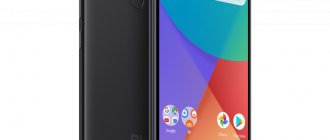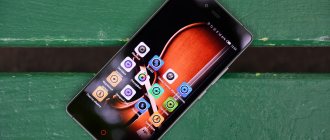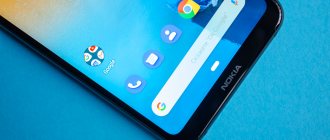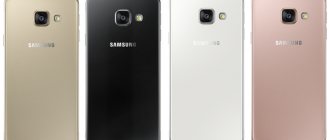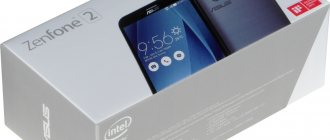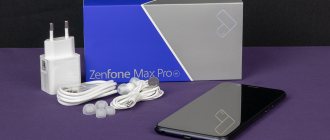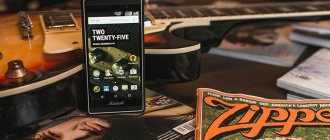Until recently, the flagship of the line of Android devices was the HTC One X, announced at MWC 2012. We undeservedly ignored this phone in reviews for one simple reason - for a very long time we hoped that the HTC One XL, which is the same One X, would come to us , but capable of operating in LTE networks at Russian frequencies plus with a Qualcomm processor instead of NVIDIA Tegra 3.
One XL has not yet officially begun to be sold in Russia - it is being brought to our country in gray from distant Hong Kong. But HTC has updated the One X, replacing it with the updated One X+ model, and it is already on sale. We decided that this was a good enough reason to correct the omission and test the device, killing two birds with one stone: on the one hand, we are talking about the new model, on the other hand, a review of a smartphone very close in characteristics to the One X will appear on the site .
⇡#Appearance
In appearance, the One X+ is still the same good old One X, which almost a year after the announcement did not look any worse (however, it was also better). The changes are minor: the designers added several color accents to the monotonous black color of the original smartphone. The color addition is the same for both versions of the smartphone: both the black and white HTC One X+ have red splashes.
There are few red accents: three icons of touch buttons on the front panel, a bezel around the camera eye and an enlarged Beats logo on the back. Everything else is black: a dark dark black panel under the glass, plus a single plastic part of the body of a slightly lighter shade and with a soft touch coating. The original One X did not have this coating, so the body was subjectively “harder” to the touch, but less scratchy: on the new device, minor coating defects appear quite quickly.
The device is still non-separable; you can only change the MicroSIM card, the slide for which is located on top, next to the power button. They are extracted in the traditional way - using the popular “i-clip”.
In terms of size, the HTC One X+ is close to the Galaxy S III: the “Korean” is 2 and a half millimeters longer than the “Taiwanese”, less than a millimeter wider and 0.3 thinner. Despite the almost identical dimensions, subjectively the One X+ seems a little larger than its competitor. They weigh the same: Samsung - 133 grams, HTC - 135. At the same time, the One X+ body bends slightly under strong pressure, but does it “silently”, and the Galaxy S III is almost reinforced concrete in bending, but creaks slightly due to the collapsible body.
⇡#Screen
If we forget about such unsteady and fleeting reasons for choosing a particular device, such as prices and brands, the bottom line will probably be only two rational reasons to prefer One X+ to a similar product from a small South Korean company. The first is the plastic of the body. The second is the display. Because not everyone likes the strange color rendering of AMOLED. But it’s simply impossible not to love the HTC One X+ display for its color reproduction. The color gamut matches the sRGB color space almost perfectly. The white temperature is close to 7000 K.
Color gamut of the HTC One X+ display in splendid isolation (left) and in comparison with competitors (right)
The maximum screen brightness, according to our measurements, was about 370 cd/m2. Compared to the iPhone 5, this may seem like a low result. But this is the right time to remember about power consumption: a larger HTC One X+ display would require almost twice the total luminous flux to achieve the same brightness - and its “gluttony” would correspondingly increase.
In terms of contrast, the One X+ display is almost as good as the iPhone screen. But it seriously loses to the Galaxy S III screen - and indeed to any AMOLED display, because compared to LCD matrices, the black luminosity in them is an order of magnitude lower.
⇡#Iron
One X was built on the NVIDIA Tegra 3 platform in the fastest version available at that time, T33. It pretty much frightened gadget lovers with the number of cores (four? five? four and a half?) and their frequency - as much as 1.4 GHz (1.5 in single-core mode).
However, this was not enough for HTC’s designers, so in the “plus” version of their flagship they decided to use an even more powerful variation of the Tegra, which became available not so long ago - AP37. This beast is distinguished by increased frequencies of the processor (1.6 GHz with the ability to increase to 1.7 in turbo mode when loading one core), graphics core and memory.
Graphics are the main trump card of Tegra 3; it’s not for nothing that this chip is made by one of the two graphics giants. Twelve stream processors of the GeForce ULP accelerator in Tegra 3 AP37 operate at a frequency of 520 MHz - 104 MHz more than the One X. The same amount of RAM is 1 GB LPDDR2.
Another difference from the original model is that the built-in flash memory can now be 64 GB, while the One X existed in a single version, with 32 GB. One X+ of this volume is also found in nature, so you need to choose carefully. In Russian retail, however, the share of such devices is vanishingly small. There is still no slot for a MicroSD memory card, but now this is not so critical.
As mentioned above, this model had two LTE versions: one for the States (where it was called One X for AT&T) and the second for all other countries - One XL. The latter, in particular, had support for LTE on Russian frequencies. Both versions were based on the Qualcomm S4 MSM8960 processor. The fact that HTC made the LTE version on a different processor gave rise to a strong belief: that Tegra 3 is, in principle, incapable of working with LTE.
One X+ refutes these rumors with its existence. Despite the fact that there will again be versions both with and without LTE support, the same Tegra will be used in all cases. And only the external communication processors will differ: the 3G version will use Intel XMM6260, and the 4G version will use Qualcomm MDM9215.
Actually, we received the LTE version of the smartphone for testing, equipped, of course, with Tegra. One sad thing is that LTE on the MegaFon network refused to work even after a forced switch through the smartphone’s engineering menu. However, so far there is no practical significance in all this: in Russia, at least for now, One X+ is supplied in a version without LTE.
HTC One review
If you could bring your own standards to the Chamber of Weights and Measures, then I would not regret my HTC One as a standard for the “WOW effect”. This smartphone is not without its shortcomings, but against the backdrop of the gloomy, monotonous “shovels” it looks very impressive and contrasting... perhaps the only contrasting things are the zebra stripes and the ice-cold shower when the hot water is turned off. Jokes aside, this is the first smartphone since the HTC HD2 that I irresistibly wanted to own, but for some reason it was undeservedly ignored on Habré, although no, they still wrote something about it. I'll tell you a little about him, make yourself comfortable. More than a dozen smartphones have passed through my hands - some did not last even a few days, others I put under my pillow at night for six months. The one that was most remembered (and lasted) was the HTC HD2 - a gloomy knight in armor “looking like finely polished aluminum”, which survived all the devices, endured many flashings and operating systems (from WM and WP to various variations of Android) and recently left for a well-deserved retirement - he rides around the world in a friend’s car, acting as a navigator.
Since then, I haven’t come across any particularly interesting devices. If we talk about HTC, then Desire HD seemed like a waste of time, Sensation simply did not impress, and One X for some reason was made on Tegra... I didn’t even want to look at non-flagship devices - either the processor is from the past, or they are greedy with memory, or The camera is lousy. But the worst thing is that all the models were without any special features, covered with a layer of indifference and indifference from the manufacturer himself.
At the beginning of 2k13 I saw the light at the end of the tunnel. “Really, really, did someone at HTC hear my prayers! A top-end device, a decent battery, an excellent design and no bad amount of megapixels in the camera!” - don’t think that I’m trying to find an excuse for a 4-megapixel camera, although, you see, these crazy races have already reached the point of absurdity.
HTC One is the first smart phone since the HD2 that I wanted like the most beautiful girl at university. As you already understand, in the end everything worked out for us, we have been living together for more than a month, soul to soul. I won’t tell you intimate details - you can contact Yandex.Market for them, where more than 40 reviews have been written about this smartphone. And at the same time, read the reviews so that you don’t think that I’m making something up here.
As you already understand, in the end everything worked out for us, we have been living together for more than a month, soul to soul. I won’t tell you intimate details - you can contact Yandex.Market for them, where more than 40 reviews have been written about this smartphone. And at the same time, read the reviews so that you don’t think that I’m making something up here.
The theater begins with a hanger, the military registration and enlistment office begins with an agenda, and new devices begin with a box. The flagship device, originally from Taiwan, is packaged in a kind of thin Mac Mini. Packaging in the form of a “brick” began to go out of fashion - manufacturers realized that they were very reluctant to build houses from them, so they began to produce other building materials.
But what remains depressingly constant is the contents of the boxes: a smartphone, a wired stereo headset, a charger and a USB cable. Oh, where have the times gone with boxes that don’t close with cases, docking stations, extra batteries, thirty-three books with instructions?!!!
Design. Design... Design is a subjective thing, some people like it, others don’t. But I was as happy as a child when I first saw One. Neat strict lines, excellent exterior in both light and dark design, metal - not like Samsung. On the other hand, the motivation of the creators of the fourth galaxy can also be understood: a plastic collapsible case is a classic, simple, cheap and reliable, however, my HD2 had a metal removable battery cover and somehow everything held together, no one died.
Here is a different approach to the very idea of a monolithic body. It is completely cut out of a single piece of aluminum, with all the technological holes, grooves, recesses and everything, everything, everything else. Sturdy unibody case, there is simply nothing to loosen or creak, everything is monolithic.
At some point it even seemed to me that this smartphone was released by the company... well, no, it seemed. Although millions of flies cannot be wrong, Apple adherents themselves wrote somewhere that the front of the new HTC One is exactly the same as their old one iPhone 5 from behind.
Although millions of flies cannot be wrong, Apple adherents themselves wrote somewhere that the front of the new HTC One is exactly the same as their old one iPhone 5 from behind.
There are two body colors to choose from: black (anodized) and silver (as is). I chose gray because I finally decided to switch to the light side; it’s not so easily soiled, and I’m already tired of the black color. But in general, the choice of colors could be borrowed from some Nokia Lumia: Gunmetal Gray, say, some Amber Red, or even Sapphire Blue - such things would definitely find their audience.
The photo is borrowed from the HTC blog.
Almost the entire front side is covered with Gorilla Glass 2, the properties of which do not need any introduction (it cannot be scratched with a knife or a nail, but a ruthless jeans pocket will still cover the entire glass with micro-scratches within a year; in general, I am a supporter of matte film — not against scratches, but for aesthetics). Glass and metal... oh, they’re unlikely to come up with anything better. By the way, there is information on the Internet about a possible defect (protruding glass), pay attention to this when purchasing.
Glass and metal... oh, they’re unlikely to come up with anything better. By the way, there is information on the Internet about a possible defect (protruding glass), pay attention to this when purchasing.
Pay attention to the completely non-protruding volume button. What, don't you see her? =)
On the front side, the device is almost symmetrical (to the touch): on top there is a duck-face camera (2.1 MP) and two sensors (lighting and proximity), as well as a status LED, which is neatly hidden in one of the holes in the speaker grill. Below there is only a microphone and the same mesh, behind which hides not only the microphone, but also... a second speaker! Thus, here is an “honest” two-channel sound:
They even came up with a new brand for this - Boomsound (in addition to Beats Audio) - the sound is quite loud, you can easily sound even a spacious open-space office. The quality is also not bad, although I prefer listening to music through headphones rather than through speakers (the standard headset is also quite good).
But once again they got tricky with the controls. Previously, HTC abandoned hardware buttons and changed the order of the touch buttons, but now they’ve come up with something new. Have you already noticed the touch buttons at the bottom of the screen? No, you didn’t think so – there are really two of them: “Back” and “Home”.
Where is the much-needed “Menu” button? But if it’s not there, I’m at a loss as to what the company’s engineers were guided by when they implemented such an antisocial solution into the final product. And, apparently, there is no way to fix this. But on the other hand... it’s all a matter of habit - I’ve been using the device for a month now and I seem to be getting by somehow - in landscape orientation it’s convenient, on the contrary, that you can press the device harder with your thumb without fear of accidental pressing.
The left side is unusually empty - there is only a slot for a microSIM card. On the right is similar, only an engraved two-position button for controlling the volume. By the way, there are also questions about the latter... why is it so indistinct? It is almost impossible to find it by touch, and even if you find it, sometimes it is not clear whether you pressed it or not. And I thought that the buttons on the Nexus 4 were inconvenient, yeah... In general, another flaw, but again... the volume... how often do you change it? If I change it, it’s only when I listen to music on headphones - by means of a regulator on the wire.
The power button also decided to mock the user and moved to the left side of the upper end, which is why it is convenient to press it only with the index finger of your right hand (I am right-handed). It’s good that the device is not quite gigantic in size and allows you to control it with one hand, without intercepting it. But it would still be better if the power button was the old fashioned way, on the side...
But the power button has one interesting feature - it is also an infrared port! No, for transmitting pictures and polyphonic melodies in the corridors there is all the necessary arsenal of wireless interfaces, and the port is useful for controlling home equipment. The standard software arsenal includes the “TV” application, which displays the TV program schedule for many channels (Russia, unfortunately, is not yet supported there) - it has a built-in ability to control various equipment (TVs, set-top boxes and home theaters) - many models are preinstalled devices, although my noname TV, naturally, was not there. No problem - I added it in manual mode, “teaching” the necessary commands (the smartphone tells you which button to press on the remote control, and then “catch” the signal and wrap it around).
As a result, only the condo took part in the uprising of the machines; all other household appliances were tamed. It’s just that getting to these “remotes” inside the application is inconvenient - I would be grateful if someone could suggest similar software (maybe paid).
At the bottom end there is a MicroUSB connector, which serves not only for charging or connecting the device to a computer. For additional money (equal to the cost of an MHL adapter), you can plug in an HDMI cable, as well as (via another adapter) a regular flash drive or digital camera (USB On-The-Go with support for FAT/FAT32/NTFS file systems, and maybe some others). The last feature is quite useful - you should pay attention to it if you do not have enough built-in memory. Yes, yes, HTC One is also in trend - there is no memory card slot, and there is not so much built-in memory. In Russia, only the 32-gigabyte version of the smartphone is sold (Europe is luckier, you can find 64 gigabytes), with only about 25 gigabytes allocated for user data. The Chinese are luckiest of all - their version has not only a slot for a memory card, but also a place for second SIM card! By the way, smartphone buyers are provided with a nice bonus - 20 GB in a Dropbox account.
On the reverse side everything is smooth and beautiful. Hidden behind thin strips of plastic are antennas for cellular communications and short-range networks, Wi-Fi, Bluetooth and even NFC (Android Beam works, but the Yandex.Metro application does not show the number of trips, at least on the blue “Unified” pass) . Apart from plastic strips and a 4 MPx camera eye, there is nothing else on the rear panel.
I deliberately saved a couple of paragraphs of text about the screen for “dessert,” which, in my opinion, deserves special (or main) praise. The Super LCD3 display, with a diagonal of 4.7 inches, is no longer a “small” 4.5-inch screen, but at the same time it is not yet a giant 5-inch screen. People call this the golden mean, although something tells me that a 5-inch screen would also fit perfectly here - pay attention to the half-centimeter frames around the perimeter.
But the coolest thing is the rest of the display characteristics, such as resolution (1920x1080 - like a giant TV in your home!), maximum viewing angles, excellent brightness reserve, natural color reproduction and overall speed. Pixels? I beg you, there is no trace of them. The dot density is 469dpi - in my opinion, no one has a more precise indicator. And, unlike interpolated megapixels in cameras, here all the beauty of the screen is visible to the naked eye. In short, the screen is great, and HTC also preinstalled such juicy pictures...!!!
What do we end up with? A month later, the device has not lost its presentation - it is still a stylish and practical metal case with a gorgeous screen. I got used to the size right away - the smartphone is comfortable both in one hand and in a jeans pocket.
Everything inside the device is also mature. Qualcomm Snapdragon 600 with four cores with Krait 300 architecture, second-generation Adreno 320 video core, 2 gigs of RAM - yes, it just turns on in 6 seconds! This device simply does not know what “slow down” means, and the word “slow” is difficult to understand. Clicked and it was done, swiped and the animation was perfectly smooth, opened the application and it launched instantly. In everyday operations, the One is twice as fast as an iPhone, the usability of the OS has long been not only “equal”, but has moved into the stage of “it’s still unknown who has it better.” Personally, I’m not a fan of iOS (the only thing that captivates me is their “ecosystem”), since many decisions in the field of UI and interaction with the system are not obvious and are a legacy of the limitations of the first versions.
Okay, we got distracted. Performance. Anyone here interested in equestrian-spherical benchmark performance? Unfortunately, it won’t be possible to ask before publishing the post, so here are the pictures, they will say everything for me:
As you can see, the device confidently outperforms even the most powerful solutions of last year - Nexus 4 and Optimus G (although their performance already seemed excessive and sufficient for a couple of years to come). There is nothing to say about the other models. It’s a little more difficult to compete with the new flagships, but here the One hasn’t lost face in the dirt: it may have scored fewer “parrots” than ARM-15 processors, but in reality you won’t see any lags on the One, while My friend's Galaxy S4 periodically produces microfreezes. Although, most likely, this is the merit of the crooked software writers from Samsung, and not the hardware.
Of course, there are no problems with games either. I’m not a particular fan of mobile toys, but you can play some racing games or “piggy” games on public transport, but all sorts of DeadTriggers are not my thing. The performance is absolutely enough to produce a 1080p picture with 30+ FPS, and anyone who wants can watch this video:
I wonder if EA will ever think of porting the first NFS Underground to mobile devices? Eron-don-don, yeah.
We talked about the filling, now the burning topic has come - the battery. For once, HTC was not greedy: an impressive 2300 milliamp hours are hidden inside (the highest figure for the entire line of One devices of the same name) - the device works from morning to evening, like all modern smartphones. But even such a battery, if you really want to, can be discharged in a few hours by turning the brightness to maximum, downloading a movie over 3G and playing Asphalt 7. However, you can just as easily charge a Nexus, a Galaxy, an iPhone, or even a 60- ampere car battery.
To sum it up very briefly: it doesn’t slow down, the autonomy is like all modern devices, 1 day. No, but what did you want from a device that costs twenty thousand rubles? This is the flagship 
At the time of writing, the smartphone seemed to have the latest software, namely: - Android version 4.1.2 (Jelly Bean) - HTC Sense 5.0 - Firmware 1.29.401.12
It’s difficult to say anything new about Android itself - it’s been studied far and wide, and this version is now installed on most modern smartphones (while some models have been running 4.2 for several days now). HTC One (as well as HTC Butterfly) also promises an update to 4.2... but... well, you understand) So, if anything happens, don’t say that it’s all my fault.
But HTC Sense here is the latest version, the fifth - only HTC One and Michael Jackson have this. The first thing that catches your eye is an attempt to join the trend of flat Windows 8 and modern Android trends: most of the elements, which were once embossed and gradient, have become monochrome and have lost any volume. Flat design, or whatever it’s called...
True, while some icons seem to be of different design (here we are not even talking about third-party applications, but about pre-installed ones), but in general it looks very, very cool. Several years later, this shell remains my favorite - one of the best conversions of stock Android. Same Samsung still can’t get rid of the colorful Asian look with a bunch of frills (despite the fact that the functionality is quite good), and LG... steal ideas from Samsung and paint ugly icons on them 
In the fifth version, all icons, switches, clocks and weather information have been redrawn. The design has become cleaner and, if not strict, then at least more neutral - matching the sharp edges of the device itself - just right!
There are many widgets at your disposal (the usual clock on the white display and the weather have not gone away), and the main menu finally has a standard ability to group applications (with the ability to display them in alphabetical order or by activity, as well as change the grid - 3x4 or 4x5 ). If applications are not grouped, then they can be scrolled down endlessly. At the very top of this menu there is also a clock and weather, which cannot be removed.
Another “locked element” is application shortcuts on the lock screen; you can’t even change them. Despite the fact that the rest of the lock screen can be changed as you like - display only the weather clock, music control buttons, photo album or something else.
Initially, three desktops are preinstalled, on one of which (on the main one, where the “Home” button leads) something called BlinkFeed
. At first I thought it was just another news aggregator... but that’s exactly what it turned out to be. The debut of a peculiar thing, which I did not find much use for, despite its very pleasant appearance.
At the moment, news for Russia is displayed there (pre-formatted and compressed to save traffic on HTC servers) from a sect of selected sites, such as RIA Novosti, Vesti, Gazeta.ru, Reuters, Euronews, Auto.Mail.ru, Nomobile.ru... Eh, WHERE IS HABR?!!! But there is no Habr. As well as the ability to specify any arbitrary resource. You don’t know, you don’t know... as for me, it’s better to read a Twitter feed or an RSS feed, but here you can’t even remove this thing from your desktop. Here.
I liked how they solved the problem with low-grade images that you assigned to contacts (more precisely, which Google itself at one time compressed). If such an image is present during a call, a mesh filter is applied to the photo, which hides image defects, while leaving the photo of the calling person recognizable.
Otherwise, in terms of pre-installed software, it’s quite clean and not cluttered. The file manager is still not included in the package, but the task manager has been slightly transformed: if in the previous version of Sense (I saw it on the HTC Butterfly) there was an inconvenient carousel (you had to try very hard to “catch” the desired application there), now the task manager called by double-clicking the Home button and is a static 3x3 grid.
You can read more about the innovations and capabilities of this shell here, but, as they say, it’s better to see once:
Are you still here? If so, then I propose to discuss the most controversial element of a smartphone - the camera. The technical characteristics of the production sample are as follows: a 4-megapixel BSI sensor with a matrix size of 1/3′, a wide-angle lens with an equivalent focal length of 28 millimeters and a viewing angle of 88 degrees, an f/2.0 aperture and an optical stabilizer. A separate processor is responsible for retrieving information from the module: HTC ImageChip 2. The main feature is precisely the increased pixel size of the matrix - 2 micrometers, while in most other mobile matrices it is smaller. Like, in this case, more light falls on it... wow, how many copies were broken in discussions of the “ultrapixel” matrix, which they decided to install in One. Some shouted that “4 megapixels will be laughed at”, others - “Hurray, finally less noise and more light sensitivity” - we can continue in the comments 
But you can discuss it endlessly, but the camera still takes photographs that first of all need to be seen, and not described in beautiful words. Here, see examples of photographs in full:
As you can see, Nikon and Kenon stocks can sleep peacefully. The camera cannot be called ideal, although I have only a few significant comments about it.
The camera cannot be called ideal, although I have only a few significant comments about it.
Under ideal shooting conditions, the quality of the frames (picture clarity) is excellent, although it is slightly inferior to the fourth (and maybe even the third, you have to look) Galaxy, fifth iPhone and flagship devices from Sony - the pictures are too contrasty, and sometimes there is not enough detail in small details . But the frames are obtained with normal colors, without any problems with white balance, and autofocus clings to exactly the object you want.
The stabilizer saves you from tremors; HTC didn’t lie about the light sensitivity of the matrix. A separate point I liked was the ability to take HDR photos. Previously, this abbreviation caused an internal fear in me - that I had to take 3-4 frames from a tripod (without breathing), then in some cunning way (according to one of the lessons on the Internet) put these photos together... and then, wow, maybe... it would turn out that something hitherto unprecedented... In HTC One, the principle of operation is the same, only it does everything itself and by pressing one button (on the same basis as creating a regular photo). The result is that photographs are “stretched” from the “sky and silhouettes” or “photos and black objects” state into quite acceptable frames: exposure compensation works with a bang, details appear in dark areas, light and overexposed areas are corrected in the right direction. Compare the results of normal and HDR mode:
Unless HTC One can do “day” in the dark, like the Nokia Lumia 920 does. But, apparently, there was no such task... it turns out a little dark (lighter than on the iPhone), but the situation is more or less natural (albeit with noise).
In addition, HTC has released a special photo software Zoe
, which can do magic no worse than David Blaine - make people disappear, control time in photos, pretend to be Photoshop, and in general this is one of the best mobile photo editors. Here, of course, I lied a little, but you really don’t plan to edit photos on your phone? But in vain, because one Photoshop costs at least as much as an HTC One, but here everything is free for you.
We started the camera - you can press the shutter button the old-fashioned way (it’s a pity that there is no hardware button for this purpose) and immediately take a photo. But what if the shooting conditions are uncomfortable? For example, are there people running around in the frame, cars driving, etc.? In this case, you can switch to the aforementioned Zoe mode in one click: after trying to create a photo, you will have... as many as 20 full-size photos in the device’s memory (by the way, each weighs 1-2 MB), and in the gallery they will be grouped into a video. A kind of serial shooting, for which you don’t need to navigate through the menu... and at the end of the day at least one frame will do.
There is a built-in photo editor that allows you to edit some basic things. For example, remove red eyes, “smooth” the skin (by adding a warm lamp blur, vaguely reminiscent of the ImageNomic Portraiture plugin), change the geometry of the face (works!), lighten-darken, crop in every possible way, apply effects (there are about 10 of them) and all sorts there are frames. Beauty!
I didn’t try to take panoramas because I haven’t seen anything beautiful yet. But yesterday, just for fun, I tried the function from the train window - don’t take it to heart =)
The network is full of other examples of panoramas, apparently it works. And if something doesn’t suit you, you can always use a third-party utility from the Play Store.
All photos are in full size.
When talking about HTC One, one cannot fail to mention its competitors. But I’ll say in advance: for the most part, they don’t excite me. My friends have everything listed below (but it’s not easy to gather everyone at once at one spatio-temporal point), I tried it... so the holivar stuffing, in short, is:
- Sony Xperia Z
is a stylish and sophisticated thing, but with a defective screen (TFT TN) and battery. Waterproof properties - who really needs them? In 10 years, I haven’t had any problems with any of my smartphones in any downpour, and I wouldn’t go swimming in a pool with just any phone. The standard interface is also very dull. - LG
themselves, although the Nexus 4 is very good. His brother Optimus G? In some ways it’s better than the Nexus, in some ways it’s worse, but this device is technically of the previous generation (720p and “last year’s” processor). I wouldn’t say that the hardware capabilities of these devices are not enough, but I don’t like the design of the G, and the 16 gigs of the Nexus is a mockery. Perhaps the G Pro will kick things up a notch, but it's not even on sale yet... and it's more of a competitor to the Note 2, with its spade physique. - Nokia Lumia 920
? I really liked the hardware and appearance of the device, it has many strong points... but Windows Phone... tell me, is it possible to install Android here? If not, then turn it back. - iPhone 5
is inferior in characteristics to many models and in many respects, but overall it is good and I probably even like it. But I think that peeling paint on devices of this level is simply unacceptable, and breaking the OS for the sake of 20 tweaks in order to get what Android has out of the box... despite the fact that you can buy a device that you like better both externally and internally... how- that's strange, right? And where are we, ordinary Android beggars, compared to these iOS oligarchs) - Samsung Galaxy S4
— perhaps the strongest of the competitors, although I also found something to dig into in it. It seems that the characteristics (camera, Android 4.2, memory card slot, etc.) are at the same level, and the repeated appearance is not so bad... but no, I’m not yet ready to give a kilobucks for plastic with epileptic TouchWiz. For its price, I expect a little more from the device... well, or I want the price a little lower, by 20-25 percent
They recently released S4 with bare Android on board - if you close your eyes to what was described above, then it’s an option... but it also won’t work out cheap.
In short... after reading comments on the Internet, looking through forums, touching devices in stores... I think that I made the right choice. Yes, even if the future is vague... but recently I caught myself thinking that I’m tired of playing “construction sets” at night - I want it to just live on its own. Therefore, I won’t be at all upset if after six months there is no update - everything works fine without it (even now).
⇡#Performance
In general, the thought of complaining about the power of a quad-core smartphone did not occur to us. Linpack's results immediately demonstrate that four cores are not two at all: multi-threaded calculations are three times faster than single-threaded calculations. In general, not purely processor disciplines, Tegra 3 also does not lose face. For example, the Sony Xperia S with a good, albeit already elderly Qualcomm Snapdragon MSM8260 is more than twice as behind in the Quadrant test.
The browser benchmarks that we ran in the “native” browser from HTC Sense also show good results: Sunspider runs only slightly slower than in record-breaking devices running Windows Phone 8. A small funny thing happened in Browsermark 2.0 - the smartphone benchmark runs with quite decent speed, but HTC's proprietary browser is not able to properly display the start page on the Rightware website. So it’s better to install something third-party, like Google Chrome, to avoid problems.
There is also no need to complain about the built-in graphics - overclocked GeForce ULP: in Nenamark 2 One X+ it produces about 60 frames per second. However, in more complex tests everything is not so rosy - in Basemark Taiji the average FPS stopped at a dismal 15.6. So even though Tegra 3 was created with gaming in mind, its power may soon not be enough. It’s not for nothing that there are rumors about the announcement of the fourth generation Tegra already at CES 2013.
Perhaps we should add a few five-kopeck notes about games and Tegra Zone. Let's start with the last one - despite the presence of Tegra itself in the smartphone, NVIDIA's proprietary game store is not pre-installed. At the same time, on HTC One X+ in the usual way - that is, through Google Play - you can install those games that are currently exclusive to this platform. Let's say there is a Zombie Driver for One X+ on Google Play, but not yet for SGS III. In a few months, the exclusive rights will end and the game will be available to everyone.
NVIDIA says that some games on devices with the third Tegra do not look the same as on other smartphones. We have to specifically look for differences, so this time, due to the New Year’s bustle, we didn’t do it. But you can look at them in the review of another Tegra 3 device - ASUS Transformer Prime, there is a very clear frame-by-frame comparison.
Camera
The HTC One's camera is a real sticking point. She is both good and not so good at the same time. At the presentation in London, HTC forgot to mention the number of MP, but paid a lot of attention to the fact that the smartphone has an Ultrapixel camera. The size of each pixel placed on a 1/3” matrix has been increased from 1.4 micrometers to 2 and receives several times more light. Thus, the photos should be of higher quality. But there is a problem - large pixels could fit on a sensor of the same size only if the number of these pixels was reduced; there are about 4 million of them left. Yes, the HTC One has a 4 MP camera and this does not sound solid, but do not rush to immediately criticize the smartphone for this, After all, it’s stupid to measure megapixels, we all know how poorly a 13 MP smartphone can take pictures. On a Full HD monitor you see only 2 MP, so the photo itself is twice as large. My opinion is that there may be fewer megapixels, but better quality, and that’s what HTC tried to do. And it worked partly, in low light conditions the pictures are better than with the SGS4 and iPhone 5, but overall, there was no revolution. The quality of images in daylight is practically no different from that of the iPhone 5 or SGS4, but the detail is worse.
Below you can see how different photos taken with a 4 MP smartphone and with an 8 MP will be in real life.
Unfortunately, I can’t say that the One shoots even as well as the iPhone 5 in daylight; often light colors simply fall through in photos (like the building above), while the iPhone draws out shades. Below are some comparison photos taken on HTC One and iPhone 5.
But the standard HDR mode in HTC One is clearly superior to that in the iPhone:
The front camera in HTC One still takes photos in a strange way, but draws everything, unlike the one in the iPhone.
And a few more photos from HTC One:
Video examples:
I would also like to mention the quality of sound recording in videos; even at concerts you can get a good track, better than in 99% of other smartphones. Overall, I'm more pleased with the camera than not. In the first public versions of the firmware, the pictures were not nearly as high quality as they are now, perhaps the camera is still being worked on and soon it will take even better pictures. One thing I can say for sure is that the Nokia 808 PureView will definitely not live up to it)
There are no complaints about the camera software, everything is convenient and understandable. I really liked the ability to switch between the main and front cameras by simply swiping across the screen.
⇡#Battery
One of the most noticeable differences between One X+ and One X is the battery increased from 1800 to 2100 mAh (7.77 Wh for the new product versus 6.66 Wh for the previous flagship at the same voltage - 3.7 V). At the same time, the weight has increased by only 5 grams, so the capacity-to-weight ratio of the battery is clearly better than it was in the One X. An increase in battery capacity by as much as 15% is the joy of any Android owner, and even in a phone with a powerful and quite voracious Tegra. - especially.
In the synthetic battery benchmark Antutu Tester, our test subject scores 445 points, beating, say, the LG Optimus L9 we recently tested with a much more sluggish processor and a slightly more capacious battery.
And with normal use, One X+ lasts about a day and a half. Only the ferocious and merciless Yandex.Navigator can quickly defuse it. When trying to charge a smartphone from a car electrical outlet with the Navigator turned on, the poor X+ plaintively displayed a message on the screen stating that it was discharging much faster than it was charging, and it would be better to turn off the harsh Soviet navigation. No, there are no complaints about One X+ - only about domestic developers.
In general, compared to the One X, the new smartphone has become much more suitable for everyday use - if you remember to charge it in the evening, it is guaranteed not to run out in the middle of the day. True, this is also the merit of the software, but more on that later.
⇡#Camera
HTC is trying to focus on photo and video shooting in its new devices. This is expressed not only and not so much in quality, but in additional capabilities. For example, the 8-megapixel camera on the One X+ offers burst shooting at breakneck speed. The phone does not have a dedicated camera key, but just hold down the button on the screen - and the device, like a sewing machine, starts stitching frame by frame at a speed of 4 pictures per second.
The One X+ camera can also take photos while recording video. However, in this case, the device spends a lot of time on each photo and the result most often turns out blurry, unless you shoot in ideal lighting conditions. Nevertheless, the opportunity is useful - it often happens that you want to take a frame out of a video, but it turns out to be completely “inedible”. In this case, the proprietary Taiwanese twist comes in handy.
The HTC One X+ has a not very pleasant undocumented feature: an overly harsh noise reduction coupled with an overly smart processor turns photos into cartoon graphics, removing a considerable part of the colors and details. At the same time, there are no special problems with white balance or exposure metering, autofocus works great, so the pictures look very good on the phone screen - if you don’t try to zoom in on any area. The apparent sharpness turns out to be a ladder, and in more or less monochromatic areas all small information is lost - for example,
, in places it is a smooth texture, and the upholstery of the sofa turns to stone.
If you leave the flash in automatic mode, it fires a little more often than necessary - the device is on the safe side. But in the dark the pictures come out quite decent.
The One X+ shoots video very well - as far as a mobile phone is capable of it. Vivid, natural colors, full Full HD - everything is great. There are only two complaints: firstly, the microphone collects excess noise, and secondly, there is no stabilizer, so hand shaking is felt quite clearly.
Sound One
Usually, when I describe my impressions of smartphones, I don’t specifically highlight this section. I don’t listen to music very often myself, and I don’t understand the topic, to be honest. In my opinion, now all expensive devices play approximately equally well. But HTC One is an exception. Another of its features is BoomSound.
The smartphone is equipped with two stereo speakers located on the front panel. This is rare among mobile devices. Even I, who understands little about sound quality, immediately noted how great it plays! Very clear sound, excellent stereo effect, great bass! I turned on the cartoon for the first time for my child and really listened to it! The sound in the headphones is also excellent, the included “ears” are quite good. The volume is very high.
It's worth noting that, like other top HTC smartphones, the One supports BeatsAudio software sound enhancement technology. It can be enabled or disabled in the settings.
The media player is nice and convenient, overall there is nothing special there. Well-organized music sorting and easy creation of playlists. It is possible to quickly find complete information about a composition that you heard somewhere - the player supports Gracenote services (automatically downloading album covers) and SoundHound (records a fragment of sound and searches in its database).
⇡#Soft
The HTC One X+ is equipped with the Android 4.1 Jelly Bean operating system (after all, you slowly begin to get confused with the “sweet” names - there are too many of them), covered by the proprietary HTC Sense 4+ interface. The current combination of OS and graphical shell has several differences from the pair we saw in the HTC One S smartphone with Android 4.0.
Let's start with the pleasant ones, which are probably not directly related to Sense: the device works without a hint of braking. For this, and for the increased battery life, we must thank the latest version of the green robot - the owners of the regular One X, which also recently received an update to Jelly Bean, claim that the device has begun to live one and a half times longer, and it moves faster.
The branded keyboard has changed a little - it was comfortable before, but now it has become downright wonderful. True, many will not notice this, since they will immediately install Swype or SwiftKey.
The HTC Media Link HD program has appeared, working with the TV set-top box of the same name, which allows you to wirelessly broadcast videos or photos to the big screen, controlling it all from your phone. Whoever has such consoles, please raise your hands. You are true HTC fans, but you are clearly few in number. So there is practically no benefit from the utility - it is rather an advertisement for the set-top box.
The rest of the changes are cosmetic - a new gallery, a slightly different menu design. Sense's shortcomings are the same - there are no convenient switches in the top drop-down menu, the settings are not very well organized, and the browser, as noted above, cannot boast of a normal understanding of modern layout. That is, it hasn’t gotten any worse, but it hasn’t gotten any better either. In general, the interface, as before, is beautiful - but not for everyone. Considering that the original Android shell has become noticeably more convenient over the past year, further adherence to one’s own “general party line” is becoming more of a minus for HTC smartphones than a plus.
We must not forget about the nice freebie - despite the doubling of the built-in flash memory, free 25 GB of Dropbox for two years is still waiting for happy customers. For those who actively use the cloud service, this is a very pleasant gift.
Specifications
HTC One is powered by a quad-core Qualcomm Snapdragon 600 processor clocked at 1.7 GHz. RAM 2 GB, built-in - 32 or 64. There is no slot for memory cards, but the version of the smartphone for the Chinese market has it, it’s a pity that such a model is not supplied to us. I didn’t notice any drops in fps in the interface; the smartphone works quickly. Even though the eight-core SGS4 slightly outperforms the One in synthetic benchmarks, Samsung noticeably puts some thought into even rendering the interface, although not often.
Heavy games are good, but not great. So far, there really is no Android smartphone on which Real Racing 3 would not suffer in fps, this is especially noticeable when the camera passes before the start of the race. But it’s pleasant to play, the graphics are not cut down and do not lag. However, the smartphone gets very hot during games. It stays completely cool under normal load, but heavy tasks keep the case warm. And the battery, of course, discharges quickly. The capacity of the latter is 2300 mAh and, oddly enough, the life of the smartphone is sufficient if not playing. The One easily withstood my workload for a day.
- Dimensions : 137.4 x 68.2 x 9.3 mm.
- Weight : 143 g.
- Operating system : Android 4.1.2 ICS (upgrade to 4.2.2 is expected).
- Processor : Quad-core Qualcomm Snapdragon 600, 1.7 GHz.
- Graphics : Adreno 320.
- Display : Super LCD 3, 4.7″, 1920x108o (468 ppi).
- Memory : 32/64 GB flash.
- RAM : 2 GB.
- Camera : main - 4 MP, video recording in 1080p, front - 2.1 MP.
- Wireless technologies : Wi-Fi, Bluetooth 4.0, GPS\GLONASS.
- Interface connectors : 3.5 mm headphone jack, Micro USB.
- Battery : Li-Pol battery 2300 mAh.
⇡#Conclusions
The main problem with the original HTC One X was its short battery life. This problem was partially resolved by updating to Android 4.1. So now the owners of the previous HTC flagship have at their disposal not just a beautiful and powerful phone with a good screen and other “stuffing”, but a phone that can, at the very least, keep the said “stuffing” in working condition until the end of the working day.
However, due to the very specific combination of the used processor and the capacity of the non-replaceable battery, it was impossible to solve the mentioned problem using software methods alone. And the HTC One X+ model, strictly speaking, is a hardware solution. Work on the Error, if you like.
Therefore, it is quite logical that there is nothing revolutionary in the smartphone. It just became a little better than its predecessor in several key parameters: it is even more powerful, has longer battery life, a modification has appeared with a normal amount of built-in memory and long-awaited LTE support (though it is still useless and inaccessible in the vast expanses, but we wait and believe! ).
During our entire testing of the One X+, we did not find any serious design flaws. Moreover, let's be honest, we really liked it. The only thing that confuses me is the price. At the moment, One X+ costs an average of 26,900 rubles, while One X costs a good 7,000 less. And there is also the Galaxy S III, which is even cheaper, and the lack of memory in it is corrected with a Micro SD card for 900 rubles...
So, we’ll probably give the device a subjective medal - it’s very good, beautiful and well-made, but we won’t risk recommending buying it: this, to put it mildly, is not the most rational investment of money. Something like the M Sport package for BMW - those who are close to this will understand. Perhaps these people are the target audience of the HTC One X+.
